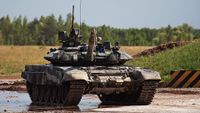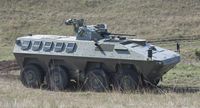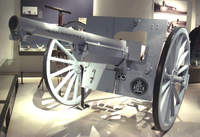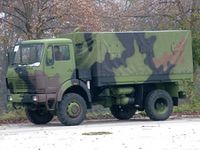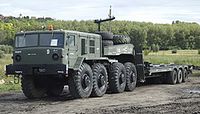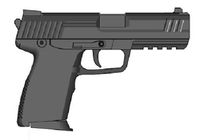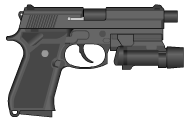Popular Levy (Niru-ye Sāzmān-e Basij-e Suren)
| Popular Levy (Niru-ye Sāzmān-e Basij-e Suren) | |
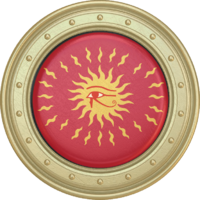 Emblem of the Popular Levy, adopted in 1692 AN following the incorporation of the Suren into the Raspur Pact. | |
| Country |
|
|---|---|
| Founded | 1686 AN |
| Disbanded | 1718 AN |
| Branches | Defence Force |
| Headquarters | Surenshahr |
| Leadership | |
| Surenšāh | Mitradokht of Suren |
| Euramehr Arteshbod | Ardashir Ghul |
| Manpower | |
| Military age | 18–65 years old |
| Conscription | Yes |
| Active personnel | 424,985 |
The Popular Levy (Niru-ye Sāzmān-e Basij-e Suren) was the primary armed force of the Suren Confederacy from its establishment in 1686 AN to its reorganisation into the Surenid Armed Forces in the period 1718 AN – 1720 AN.
Establishment
Order of Battle
- Popular Levy (Niru-ye Sāzmān-e Basij-e Suren)
- Staff of the Euramehr Arteshbod
- Surenshahr Defence Brigade
- Commissariat of the Popular Levy
- Quartermaster's Regiment
- Medical Corps
- Medical Regiment
- Veterinary Regiment
- Dental Regiment
- Logistics Corps
- Ordnance Regiment
- Supply Regiment
- 1st Transport (Motorised Wagon) Regiment
- 2nd Transport (Camel) Regiment
- 3rd Transport (Mule & Onager) Regiment
- Electrical and Mechanical Engineering Regiment
- Inspectorate of the Popular Levy
- Adjutant-General’s Regiment
- Signals Regiment
- Training Regiment
- State Gendarmerie (Žāndārmirī-ye Dowlati)
- Aspadana Division
- 9th Gendarmes Brigade
- 10th Gendarmes Brigade
- Kapavia Division
- 3rd Gendarmes Brigade
- 4th (Yemin Zoka) Gendarmes Brigade
- Norasht Division
- 5th Gendarmes Brigade
- 6th Gendarmes Brigade
- Suren Division
- 1st Gendarmes Brigade
- 2nd Gendarmes Brigade
- Trucial Isles Division
- 11th Gendarmes Brigade
- 12th Gendarmes Brigade
- Zjand Basseri Division
- 7th Gendarmes Brigade
- 8th Gendarmes Brigade
- Ghur Division
- 13th Gendarmes Brigade
- 14th Gendarmes Brigade
- Aspadana Division
- Lashkar-e-Yazatá
- Naval Forces of the Popular Levy (Niru-ye Daryâyi-e Sāzmān-e Basij-e Suren)
- Naval Command Unit
- Naval Basic Training Centre
- Maritime Surveillance Centre
- Suren Hydrographic Service
- Naval Command Unit
- Aerospace Forces of the Popular Levy (Niru-ye Havâfazây-e Sāzmān-e Basij-e Sureni)
- Kara Air Station
- Mehrshahr Air Station
- Suren Aviation Industries
- Suren Central Manufacturing Organisation
- Staff of the Euramehr Arteshbod
Land Forces
Each year the Suren Confederacy mandated the recruitment of one percent of the working-age population into the so-called Popular Levy (Niru-ye Sāzmān-e Basij-e Suren) for a four year mobilisation period, representing a total force available under arms of approximately 216,416 men. Of the established strength of the Popular Levy therefore an eighth of the force will be in cantonments undergoing their basic training for six months, while a further eighth of the force will be out on the frontiers learning fieldcraft and patrolling for a further six months. At the completion of their training year the levies would be assigned to one of the fifteen Tips (Brigades) of the State Gendarmerie (Žāndārmirī-ye Dowlati) for two years of service as mounted-light infantry and auxiliary policemen, with troops in their third year of service being responsible for the further training and discipline of new inductees into the regiments of the tip. After two years in the Gendarmerie, the levies finish their period of mobilisation by being transferred to one of the depot regiments tasked with logistics or works duties in the run up to their demobilisation period.
All individuals who complete their initial mobilisation period with the Popular Levy are permitted to return to civilian, being permitted to keep their service rifle, a tent, a silver tea set gifted by the state, four camels from the herds of the paramount chiefs of their home province, and any captives they took while on active service. In spite of being permitted to return to civilian life these levies are retained by the government on the Active Reserve until their forty-fifth birthday whereupon they are transferred to the Inactive Reserve in which they would remain until their sixty-fifth birthday. The distinction between active and inactive reserves being in their assignment and the conditions under which they would be called up. While members of the active reserve might be made subject to a patriotic service mobilisation order at any time, subject to a decree by the Shahrbān of their home province in peace time, and typically be assigned to a mobile fighting formation, the inactive reserve would only be called upon by the central government in time of war with a foreign power and even then typically be only be assigned to a static infantry formation or to the depot regiments tasked with combat support services. To prepare for future war, the Popular Levies are frequently indoctrinated about the spiritual benefits of martyrdom.
Each shahrestan[1] has two brigades of Gendarmes under the command of the Sartip (Major-General) appointed by the Shahbanu and responsible for the defence of the assigned province. A further reinforced brigade is responsible for the defence of the main capital, Surenshahr, and the royal palaces under the direct command of the Euramehr Arteshbod.
Land Equipment
| Name | Origin | Type | Quantity | Image | Notes | |
|---|---|---|---|---|---|---|
| Tanks | ||||||
| OAH Panssarsepâh IV Type 1 Zolfaqaar | Main battle tank | 25 | 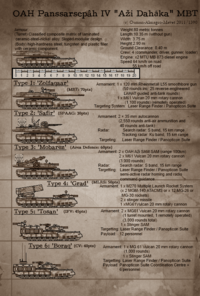
|
Surrendered by Zeed 1701 AN | ||
| OAH Panssarsepâh IV Type 2 Safir | Self-propelled anti-aircraft gun | 58 | Surrendered by Zeed 1701 AN | |||
| OAH Panssarsepâh IV Type 3 Mobarez | Self-propelled air defence | 51 | Surrendered by Zeed 1701 AN | |||
| OAH Panssarsepâh IV Type 4 Grad | Multiple rocket launcher | 46 | Surrendered by Zeed 1701 AN | |||
| OAH Panssarsepâh IV Type 5 Tosan | Infantry fighting vehicle | 48 | Surrendered by Zeed 1701 AN | |||
| OAH Panssarsepâh IV Type 6 Boraq | Command vehicle | 3 | Surrendered by Zeed 1701 AN | |||
| Pakao | Main battle tank | 4 | Recovered from Port Ulje 1690 AN | |||
| Pero | Light tank | 1 | Recovered from Port Ulje 1690 AN | |||
| Armoured fighting vehicles | ||||||
| Rz.Kfz 1714 Razkampfwagen | Armoured Patrol Vehicle | 1,096 | ||||
9A1 - Six-Axle Unarmoured Ordinance Carrier
|
Light Armoured Vehicle | 16
|
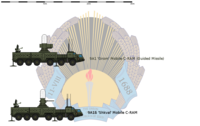
|
Surrendered by Zeed 1701 AN | ||
| OAH Ingilisi F100 | Armoured personnel carrier | 27 | 
|
Surrendered by Zeed 1701 AN | ||
| OAH Ingilisi F101 | Command vehicle | 2 | Surrendered by Zeed 1701 AN | |||
| OAH Ingilisi F102 | Wheeled anti-tank vehicle | 50 | Surrendered by Zeed 1701 AN | |||
| OAH Ingilisi F103 | Ambulance | 29 | Surrendered by Zeed 1701 AN | |||
| OAH Ingilisi F104 | Armoured transport | 484 | Surrendered by Zeed 1701 AN | |||
| OAH Ingilisi F105 | Combat bulldozer | 15 | Surrendered by Zeed 1701 AN | |||
| OAH Ingilisi F106 | Rough terrain forklift | 8 | Surrendered by Zeed 1701 AN | |||
| Vuk | Armoured Fighting Vehicle | 2 | Recovered from Port Ulje 1690 AN | |||
| S1 | Armored Personnel Carrier | 3 | Recovered from Port Ulje 1690 AN | |||
| SMFP 3000 | Armoured Recovery Vehicle | 4 | Recovered from Port Ulje 1690 AN | |||
| Field guns | ||||||
| 80mm field gun | Field gun | 2 | Recovered from Port Ulje 1690 AN | |||
| M1681 105 mm howitzer | Towed Artillery (Howitzer) | 200 | Obtained under the Fontainebleau Accords of 1691 AN | |||
| Support vehicles | ||||||
| SMFP 1000 | Off-road vehicle | 9 | Recovered from Port Ulje 1690 AN | |||
| SMFP 2000 | Tank transporter | 7 | Recovered from Port Ulje 1690 AN | |||
| Snatch Land Rover | Utility Patrol Vehicle | 25,000 | Obtained under the Fontainebleau Accords of 1691 AN | |||
| Electronic Systems | ||||||
| ES-27 Froyalan | Synthetic Aperture / Moving Target Indication (SAR/MTI) radar | 400 |
| |||
| Name | Origin | Type | Quantity | Image | Notes | |
|---|---|---|---|---|---|---|
| Handguns | ||||||
| Yurish KV-1 | Pistol | 952 | Recovered from Port Ulje 1690 AN Standard service pistol. | |||
| Yurish KV-2 | Pistol | 604 | Recovered from Port Ulje 1690 AN Standard service pistol. | |||
| Yurish KV-3 | Pistol | 426 | Recovered from Port Ulje 1690 AN Used by special forces. | |||
| M1690 machine pistol (9x19mm) | Machine pistol | 8,000 | Obtained under the Fontainebleau Accords of 1691 AN | |||
| Submachine-guns | ||||||
| M1656 submachine-gun (9x19mm) | Submachine gun | 40,000 |
| |||
| Rifles | ||||||
| M1591 7.62 mm Rifle | Bolt action service rifle | 400,000 |
| |||
| SA1680 | assault rifle | 10,000 |
| |||
| Yurish KA 7.62×39 mm assault rifle | Assault rifle | 80,769 | ||||
| Yurish KAS 7.62×39 mm assault rifle | Assault rifle | 838 | Recovered from Port Ulje 1690 AN Used by special forces. | |||
The Naval Forces of the Popular Levy (Niru-ye Daryâyi-e Sāzmān-e Basij-e Suren) was established on 05.II.1688 AN with the formation of a brigade level Naval Command Unit, based at the port of Kara, and the procurement of thirteen surplus warships (four frigates and nine corvettes) from Sanama. Future expansion plans will revolve around similar procurements and the domestic production of auxiliary vessels and patrol craft. The doctrine of the naval forces focuses upon the defence of immediate coastal waters and the exclusive economic zone (EEZ) of the Confederacy through regular patrolling, the charting of the coastline and off-shore waters, and the preparation of a layered asymmetrical defence. The Naval Basic Training Centre was established at Kara, subordinate to the Naval Command Unit on 10.II.1688 while a Maritime Surveillance Centre was established at Bandar-e Zinjibar on 13.II.1688 to collate reports of shipping movements on the Gulf of Zinjibar received from the State Gendarmerie.
The Suren Hydrographic Service (SHS) was previously established on 19.I.1688 with the dispatch of a First Lieutenant (Setvan Yekom) of the Gendarmerie to the Trucial Islands of Chamrush with orders engage local labour to raise a lighthouse on the southern promontory of the main island within two years. The garrison commander of the island, Bektash Khan, was instructed by a firman of the Surenshah to provide a squadron of levy-infantry to support the SHS through overseeing the labour corvée for the building of the lighthouse and to assist in the collection of financial contributions from the emirs of the islands.
Maritime Establishment
|
| |||||||||||||||||||||||||||||||||||||||||||||||||||||||||||||||||||||||||||||||||||||||||||
Aerospace forces

The Aerospace Forces of the Popular Levy (Niru-ye Havâfazây-e Sāzmān-e Basij-e Sureni), established on 08.X.1688, faced the invidious task of developing a tradition of aviation, and the logistical and technological capacity to support it from scratch. The Surenid rebels, then a part of the Azad Eura coalition - which would become the basis of the present confederacy, had passed through the Second Euran War without aircraft. The odd assortment of light aircraft and cargo planes assembled by the Suren under the guise of a civil aviation company (Havâpeymâye Shahrokh) having fallen into the hands of the Raspurids at the onset of the conflict between Azad Eura and Constancia. The doubtful status of relations between the Surenid and Constancia has played its part in delaying or inhibiting the operational aircraft and machine tools into the Confederacy after its formation, although a team of specialist advisors from Brightworks Mistra did make representations to the authorities in Surenshahr during the southern hemisphere winter of 1687.
The limitations of the Surenid industrial base, built around light manufacturing and the repurposing of recovered artefacts dating back to the Babkhan era, hindered the development of an indigenous aviation industry. In spite of this the Suren Central Manufacturing Organisation was able to perfect the design of the Type 1 Aero Engine, a reciprocating internal combustion engine with pistons in a radial configuration. This engine, produced on assembly lines in Surenshahr, was installed on two light aircraft types - the F-1 Homā, a metal tube frame and canvas biplane, and the F-2 Simurgh, a high-winged stressed metal monoplane with fixed landing gear - both produced by Suren Aviation Industries that formed the mainstay of the Aerospace Forces as it developed its initial cadre of pilots.
Of an entirely different order of magnitude to the light aircraft produced indigenously, both in terms of size and technological sophistication, was the vast Veliki 1 Transporter obtained from the defecting garrison of Port Ulje in 1690 AN. Presently parked on the runway at Kara Airfield, the only one in Surenid territory of sufficient length for the Veliki to have landed upon, the transporter and its internal workings is an object of study and curiosity for the country's aspiring aviation engineers.
Of the appreciable quantity of light aircraft and unmanned aerial reconnaissance vehicles accumulated during the Third Euran War the majority have been distributed evenly amongst the seven satrapan divisions, with the residue - including airframes placed into storage or assigned to training missions - held at Kara.
In 1712 AN a military aerodrome was established at Mehrshahr, primarily with the intention of serving as an aviation hub for personnel associated with the Committee of Euran Salvation which was headquartered in the city.
Aerospace equipment
| Name | Origin | Type | Quantity | Image | Notes | |
|---|---|---|---|---|---|---|
| Light aircraft | ||||||
| F-1 Homā | Light attack, trainer and communications aircraft | 180 | Production commenced 1688 AN | |||
| F-2 Simurgh | Light attack, trainer and communications aircraft | 59 | Production commenced 1690 AN | |||
| T-3 Akóntio | Jet trainer / light attack aircraft | 4 | Received under Fontainebleau Accords 1692 AN | |||
| T-4/A-4 Flecha | Turboprop trainer / light attack aircraft | 486 |
| |||
| Transport aircraft | ||||||
| C-11 Mula | Transport airplane | 24 | Received under Fontainebleau Accords 1692 AN | |||
| Veliki 1 Transporter | Transport airplane | 1 | Recovered from Port Ulje 1690 AN | |||
| Unmanned Aerial Vehicle | ||||||
| VT-UAV 1 Tadpole | Reconnaissance UAV | 200 | Received under Fontainebleau Accords 1692 AN | |||
- ^ Satrapy, a province of the confederacy possessed of significant autonomy.
